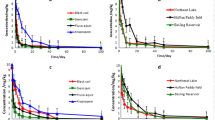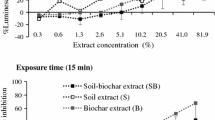Abstract
The fate and persistence of the neurotoxin β-N-methylamino-L-alanine (BMAA) and its isomers N-(2aminoethyl)glycine (AEG) and 2,4-diaminobuytric acid (DAB) in soil profiles is poorly understood. In desert environments, these cyanotoxins are commonly found in both terrestrial and adjacent marine ecosystems; they accumulate in biocrusts and groundwater catchments, and have been previously shown to persist in soil as deep as 25 cm. To determine the depth that BMAA and its isomers can be found, samples were incrementally collected every 5 cm from bedrock to surface in triplicate soil cores in a biocrust field in the terrestrial desert of Qatar. Biocrust surface samples were also collected from each core priorly. Toxins were extracted from soil sub-samples, derivatized, and analyzed with UPLC-MS/MS. All toxins were detected in all soil cores at all depths. AEG and DAB were within a quantifiable concentration threshold; however, the low concentration of BMAA was considered below the threshold for quantification. This may have environmental health implications if these toxins are able to infiltrate and contaminate the bedrock aquifer, as well as the sand and gravel aquifers. Human and animal health may also be impacted through exposure to contaminated groundwater wells or through inhalation of aerosolized particles of soil, resuspended during construction or recreational activities.



Similar content being viewed by others
References
Al-Saad H, Nasir S, Sadooni F, Alsharhan AS (2002) Stratigraphy and sedimentology of the Hofuf Formation in the State of Qatar in relation to the tectonic evolution of the East Arabian Block. Neues Jahrb fur Geol und Palaontologie - Monatshefte 2002:426–448
Anderson JM (1988) Spatiotemporal effects of invertebrates on soil processes. Biol Fertil Soils 6:216–227. https://doi.org/10.1007/BF00260818
Banack SA (2020) Second laboratory validation of β-N-methylamino-L-alanine, N-(2aminoethyl)glycine, and 2,4-diaminobuytric acid by ultra-performance liquid chromatography and tandem mass spectrometry. Neurotoxicity Research, Accepted ms. Neurotox Res
Banack SA, Downing TG, Spácil Z, Purdie EL, Metcalf JS, Downing S, Esterhuizen M, Codd GA, Cox PA (2010) Distinguishing the cyanobacterial neurotoxin β-N-methylamino-l-alanine (BMAA) from its structural isomer 2,4-diaminobutyric acid (2,4-DAB). Toxicon 56:868–879. https://doi.org/10.1016/j.toxicon.2010.06.006
Banack SA, Metcalf JS, Jiang L, Craighead D, Ilag LL, Cox PA (2012) Cyanobacteria produce N-(2-aminoethyl)glycine, a backbone for peptide nucleic acids which may have been the first genetic molecules for life on earth. PLoS One 7:e49043. https://doi.org/10.1371/journal.pone.0049043
Banack SA, Metcalf JS, Bradley WG, Cox PA (2014) Detection of cyanobacterial neurotoxin β-N-methylamino-l-alanine within shellfish in the diet of an ALS patient in Florida. Toxicon 90:167–173. https://doi.org/10.1016/j.toxicon.2014.07.018
Banack SA, Caller T, Henegan P, Haney J, Murby A, Metcalf A, Powell J, Cox P, Stommel E (2015) Detection of cyanotoxins, β-N-methylamino-L-alanine and microcystins, from a lake surrounded by cases of amyotrophic lateral sclerosis. Toxins (Basel) 7(2):322–336. https://doi.org/10.3390/toxins7020322
Belnap J, Welter JR, Grimm NB, Barger N, Ludwig JA (2005) Linkages between microbial and hydrologic prosesses in arid and semiarid watersheds. Ecology 86:298–307. https://doi.org/10.1890/03-0567
Belnap J, Weber B, Büdel B (2016) Biological soil crusts as an organizing principle in drylands. In: Weber B, Büdel B, Belnap J (eds) Biological soil crusts: an organizing principle in drylands. Springer International Publishing, Cham, pp 3–13
Bishop SL, Tymm FJM, Perry K, Kerkovius JK, Menard F, Brady A, Slater G, Lim DSS, Metcalf JS, Banack SA, Cox PA, Murch SJ (2019) Early-earth nonprotein amino acid metabolites in modern cyanobacterial microbialites. Environ Chem Lett 18:467–473. https://doi.org/10.1007/s10311-019-00943-4
Chamizo S, Cantón Y, Lázaro R et al (2012) Crust composition and disturbance drive infiltration through biological soil crusts in semiarid ecosystems. Ecosystems 15:148–161. https://doi.org/10.1007/s10021-011-9499-6
Chatziefthimiou AD, Richer R, Rowles H, Powell JT, Metcalf JS (2014) Cyanotoxins as a potential cause of dog poisonings in desert environments. Vet Rec 174:484–485. https://doi.org/10.1136/vr.g3176
Chatziefthimiou AD, Metcalf JS, Glover WB, Banack SA, Dargham SR, Richer RA (2016) Cyanobacteria and cyanotoxins are present in drinking water impoundments and groundwater wells in desert environments. Toxicon 114:75–84. https://doi.org/10.1016/j.toxicon.2016.02.016
Chatziefthimiou AD, Deitch EJ, Glover WB, Powell JT, Banack SA, Richer RA, Cox PA, Metcalf JS (2017) Analysis of neurotoxic amino acids from marine waters, microbial mats, and seafood destined for human consumption in the Arabian Gulf. Neurotox Res 33:143–152. https://doi.org/10.1007/s12640-017-9772-3
Codd G, Morrison L, Metcalf J (2005) Codd GA, Morisson LF, Metcalf JS.. Cyanobacterial toxins: risk management for health protection. Toxicol Appl Pharmacol 203: 264-272. https://doi.org/10.1016/j.taap.2004.02.016
Cox PA, Banack SA, Murch SJ, Rasmussen U, Tien G, Bidigare RR, Metcalf JS, Morrison LF, Codd GA, Bergman B (2005) Diverse taxa of cyanobacteria produce β-N-methylamino-L-alanine, a neurotoxic amino acid. Proc Natl Acad Sci U S A 102:5074–5078. https://doi.org/10.1073/pnas.0501526102
Cox PA, Richer R, Metcalf JS, Banack SA, Codd GA, Bradley WG (2009) Cyanobacteria and BMAA exposure from desert dust: a possible link to sporadic ALS among Gulf War veterans. Amyotroph Lateral Scler 10:109–117. https://doi.org/10.3109/17482960903286066
Cox PA, Davis DA, Mash DC, Metcalf JS, Banack SA (2016) Dietary exposure to an environmental toxin triggers neurofibrillary tangles and amyloid deposits in the brain. Proc R Soc B Biol Sci 283:20152397. https://doi.org/10.1098/rspb.2015.2397
Cuttler RT, Al Naimi FA (2013) From land-locked desert to maritime nation : landscape evolution and taphonomic pathways in Qatar from 14 ka. Adumatu, Riyadh. 8947:7–22
Davis DA, Cox PA, Banack SA, Lecusay PD, Garamszegi SP, Hagan MJ, Powell JT, Metcalf JS, Palmour RM, Beierschmitt A, Bradley WG, Mash DC (2020) L-serine reduces spinal cord pathology in a vervet model of preclinical ALS/MND. J Neuropathol Exp Neurol 79(4):393–406. https://doi.org/10.1093/jnen/nlaa002
Dill H, Henjes-Kunst F (2007) Strontium (Sr-87/Sr-86) and calcium isotope ratios (Ca-44/Ca-40-Ca-44/Ca-42) of the Miocene Dam Formation in Qatar: tools for stratigraphic correlation and environment analysis. Geoarabia -Manama 12:61–76
Edgell HS (2006) Arabian deserts: nature, origin and evolution. Springer Netherlands
Frenken K (2009) Irrigation in the Middle East region in figures, FAO water report - Aquastat survey. Water Rep 34:185–197
Garcia-Pichel F (2009) Cyanobacteria. In: Schaechter MBT-E of M (Third E (ed). Academic Press, Oxford, pp 107–124
Gish T, Jury W (1983) Effect of plant roots and root channels on solute transport. Trans ASAE 26:440–444. https://doi.org/10.13031/2013.33955
Hardy RA, James MR, Pates JM, Quinton JN (2017) Using real time particle tracking to understand soil particle movements during rainfall events. CATENA 150:32–38. https://doi.org/10.1016/j.catena.2016.11.005
Jungblut AD, Wilbraham J, Banack SA, Metcalf JS, Codd GA (2018) Microcystins, BMAA and BMAA isomers in 100-year-old Antarctic cyanobacterial mats collected during Captain R.F. Scott’s Discovery Expedition. Eur J Phycol 53:115–121. https://doi.org/10.1080/09670262.2018.1442587
Louis P, Galinski EA (1997) Characterization of genes for the biosynthesis of the compatible solute ectoine from Marinococcus halophilus and osmoregulated expression in Escherichia coli. Microbiology 143:1141–1149. https://doi.org/10.1099/00221287-143-4-1141
Metcalf JS, Richer R, Cox PA, Codd GA (2012) Cyanotoxins in desert environments may present a risk to human health. Sci Total Environ 421–422:118–123. https://doi.org/10.1016/j.scitotenv.2012.01.053
Metcalf JS, Banack SA, Richer R, Cox PA (2015) Neurotoxic amino acids and their isomers in desert environments. J Arid Environ 112:140–144. https://doi.org/10.1016/j.jaridenv.2014.08.002
Mohamed ZA, El-Sharouny HM, Ali WS (2007) Microcystin concentrations in the Nile River sediments and removal of microcystin-LR by sediments during batch experiments. Arch Environ Contam Toxicol 52:489–495. https://doi.org/10.1007/s00244-006-0140-1
Nigam SN, Ressler C (1966) Biosynthesis of 2,4-diaminobutyric acid from L-[3H]homoserine and DL-[1-14C]aspartic acid in Lathyrus sylvestris W.*. Biochemistry 5:3426–3431. https://doi.org/10.1021/bi00875a006
Nunn PB, Codd GA (2017) Metabolic solutions to the biosynthesis of some diaminomonocarboxylic acids in nature: formation in cyanobacteria of the neurotoxins 3-N-methyl-2,3-diaminopropanoic acid (BMAA) and 2,4-diaminobutanoic acid (2,4-DAB). Phytochemistry 144:253–270. https://doi.org/10.1016/j.phytochem.2017.09.015
O’Neal R, Chen C, Reynolds C et al (1968) The “neurotoxicity” of L-2,4-diaminobutyric acid. Biochem J 106:699–706. https://doi.org/10.1042/bj1060699
Orndorff R, Knight M, Krupansky J, et al (2018) Linking geology and geotechnical engineering in karst: the qatar geologic mapping project. In: Proceedings of the 15th Multidisciplinary Conference on Sinkholes and the Engineering and Environmental Impacts of Karst and the 3rd Appalachian Karst Symposium. National Cave and Karst Research Institute, pp 383–392
Powell JT, Chatziefthimiou AD, Banack SA, Cox PA, Metcalf JS (2013) Desert crust microorganisms, their environment, and human health. J Arid Environ 112:127–133. https://doi.org/10.1016/j.jaridenv.2013.11.004
Richer R, Anchassi D, El-Assaad I et al (2012) Variation in the coverage of biological soil crusts in the State of Qatar. J Arid Environ 78:187–190. https://doi.org/10.1016/j.jaridenv.2011.10.009
Richer R, Banack SA, Metcalf JS, Cox PA (2015) The persistence of cyanobacterial toxins in desert soils. J Arid Environ 112:134–139. https://doi.org/10.1016/j.jaridenv.2014.01.023
Sadiq AM, Nasir SJ (2002) Middle Pleistocene karst evolution in the state of Qatar, Arabian Gulf. J Cave Karst Stud 64:132–139
Scheibert C, Stietiya MH, Sommer J et al (2005) The atlas of soils for the State of Qatar. Soil classification and land use specification project for the State of Qatar, Doha
Shi T, Falkowski PG (2008) Genome evolution in cyanobacteria: the stable core and the variable shell. Proc Natl Acad Sci U S A 105:2510–2515. https://doi.org/10.1073/pnas.0711165105
Smith P, Howden M, Krug T, Masson-delmotte V (2017) Working group III (WGIII)-mitigation of climate change special report on climate change, desertification, land degradation, sustainable land management, food security, and greenhouse gas fluxes in terrestrial ecosystems (SR2) background report for the Sco. 1–32
Suzuki T, Inouye H, Fujikawa K, Suketa Y (1963) Studies on the chemical structure of colistin: I. Fractionation, molecular weight determination, amino acid and fatty acid composition*. J Biochem 54:25–33. https://doi.org/10.1093/oxfordjournals.jbchem.a127742
Svirčev Z, Lalić D, Bojadžija Savić G, et al (2019) Global geographical and historical overview of cyanotoxin distribution and cyanobacterial poisonings. Springer Berlin Heidelberg
VanEtten CH, Miller RW (1963) The neuroactive factor alpha-gamma diaminobutyric acid in angiospermous seeds. Econ Bot 17:107–109
Wang F, Michalski G, Luo H, Caffee M (2017) Role of biological soil crusts in affecting soil evolution and salt geochemistry in hyper-arid Atacama Desert, Chile. Geoderma 307:54–64. https://doi.org/10.1016/j.geoderma.2017.07.035
Watson RT, Rosswall T, Arico S et al (2005) Ecosystems and human well-being: desertification synthesis. World Resources Institute, Washington, DC
Whitton BA (Ed) (2012) Ecology of cyanobacteria II: their diversity in space and time. Springer Science & Business Media
Zastepa A, Taranu ZE, Kimpe LE, Blais JM, Gregory-Eaves I, Zurawell RW, Pick FR (2017) Reconstructing a long-term record of microcystins from the analysis of lake sediments. Sci Total Environ 579:893–901. https://doi.org/10.1016/j.scitotenv.2016.10.211
Acknowledgments
We thank the William Stamps Farish Fund and NPRP grant 4-775-1-116 from the Qatar National Research Fund (a member of Qatar Foundation) to the Brain Chemistry Labs. We wish to thank Massimo Cortesi, Jake Baur, Raviv Cohen, Stephen Blows, Eduardo Cassina, and Starr Chatziefthimiou, for their valuable help collecting the core samples, and Jacques LeBlanc and Sallie Vest, for the insight on geological phenomena and soil formation chronology. We wish to acknowledge Dr. Laith Abu Raddad and Soha R. Dargham for the guidance in the statistical analysis and the services provided by the Biostatistics, Epidemiology, and Biomathematics Research Core at Weill Cornell Medicine-Qatar.
Author information
Authors and Affiliations
Corresponding author
Additional information
Publisher’s Note
Springer Nature remains neutral with regard to jurisdictional claims in published maps and institutional affiliations.
Electronic Supplementary Material
ESM 1
(XLSX 9.32 kb)
Rights and permissions
About this article
Cite this article
Chatziefthimiou, A.D., Banack, S.A. & Cox, P.A. Biocrust-Produced Cyanotoxins Are Found Vertically in the Desert Soil Profile. Neurotox Res 39, 42–48 (2021). https://doi.org/10.1007/s12640-020-00224-x
Received:
Revised:
Accepted:
Published:
Issue Date:
DOI: https://doi.org/10.1007/s12640-020-00224-x




